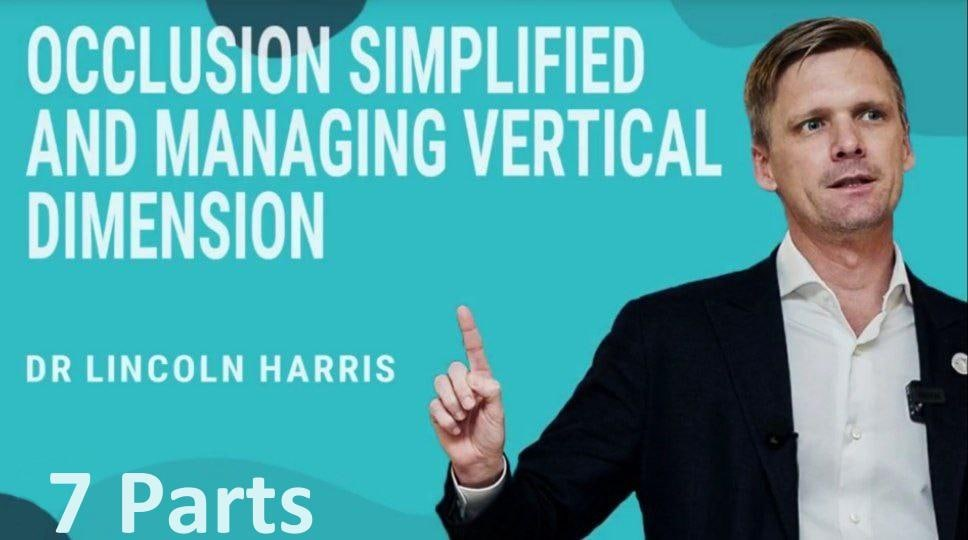Ripe Global - OCCLUSION SIMPLIFIED AND MANAGING VERTICAL DIMENSION
By : Lincoln Harris
7 Lessons (4.5 GB) (6H & 30M)
Contents _____________________________________________________________ Part 1:
What occlusion really is
Bracketed tooth
Marginal ridges
Cusps and Fissures
Considered Occlusal Adjustment
Bracketed Teeth
False Contacts
Choosing an impression tray
Planning and Records vs Adjustment and Grinding
When things break
Why do teeth break?
Static load/Fatigue
Concentrations of force
Tensile Stress
Compensating for tensile stress
Fatigue/concentrated force
Pseudo cross bite
Part 2:
Forces on the jaw
Centric relation
Class III’s and Occlusion
The lateral pterygoid
Muscle contracture
Eruption and intrusion of teeth
Occlusal disease
Occlusion matters to the dentist, not the patient
Programming of the jaw
Deprogramming
What is a leaf gauge and how to utilise them
Centric relation won’t always be the best or most comfortable position
Steep eminence and the shape of teeth
Why take protrusive records
Steep eminence visual
Shallow eminence visual
Taking protrusive records
Types of bite records
Why take a static bite
Squash bite in MIP
Rehabilitation cases and dentures
Choosing a face-bow
Checking occlusion on full mouth rehabilitation's
Restoring lost vertical dimension
Part 3:
Occlusal Adjustments
High and Low Resistance
Clenching, grinding and parafunction
Cracking of restored dentition
Splinting Teeth
Treating the toothache patient
Muscles of jaw movement
Part 4:
How to allow a denture patient to still be comfortable in many bite positions
Function and cosmetics go together
Planning treatment
Why people are phobic
Taking a bite with no vertical occlusal stops
Leaf gauges
Effects of relaxing the lateral pterygoids
Devices for deprogramming the lateral pterygoids
Face-bows
Design
Mock Up
Tooth shape and occlusion
Form is important
Plasticised layer of bysacryl
Taking a bite record
Part 5:
Types of Occlusal Splints
Protective
Palliative
Diagnostic
Mock Ups
Utilising Leaf Gauge
Bite Registration
Full Arch Rehabilitation
Temporaries
Wear
Indirect Restorative Materials
Anaesthetic Techniques
Part 6:
Opening class III bites
Opening vertical dimension
How to choose the vertical dimension
Lip mobility
Never let the patient tell you how to do dentistry.
Which teeth to build up first
The importance of photography when planning wear cases
False Consensus
Three things to know about occlusion
Do dentistry that makes you happy
Gaining experience and coping with failure
Getting started in full mouth rehabilitation cases
Choosing vertical dimension
Warning signs for those who may not tolerate opening vertical dimension.
What to use to deprogram the jaw
Canine guidance, group function or lateroprotrusive movements
Bite verification
Using a Dahl device
Kois dentofacial analysing comparison
Part 7:
Has the vertical dimension actually changed
Planning a case
Making composite veneers
When the teeth look too long
Increase vertical dimension too much
Increasing vertical dimension shouldn’t be scary
Using average numbers wont work for every patient
Maintaining the bite through FMR
The radius of opening
Protrusive bite
Lip length and vertical dimension
Transferring length design to the mouth
Maxillary excess
The relationship between form and function
Opening vertical dimension on class I pt’s
Opening vertical dimension on class II pt’s
Opening vertical dimension on class III pt’s
Steps of a case – planning to mockup
Steps of a case – prep to final crowns
